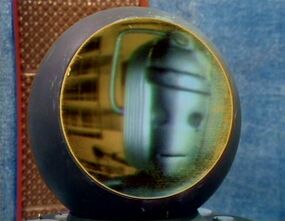Miniscope: Difference between revisions
(→Workings: supposition) |
|||
| Line 11: | Line 11: | ||
Sentient specimens were hypnotically conditioned not to notice any signs that they might have been extracted from their native environment (such as access panels in their habitat) and generally lived through a specific set of events over and over again. (The presence of this artificial [[time loop]] further suggests that the miniscope was the product of an extremely advanced civilisation.) The behaviour of the specimens could also be modified to a limited degree by the scope's operator, although the fact that (for example) artificially induced aggression affected intruders in the miniscope as well as specimens indicates that this was a separate mechanism to the conditioning. This control was only effective for creatures of some intelligence. Creatures like [[Drashig]]s were too unintelligent to control. | Sentient specimens were hypnotically conditioned not to notice any signs that they might have been extracted from their native environment (such as access panels in their habitat) and generally lived through a specific set of events over and over again. (The presence of this artificial [[time loop]] further suggests that the miniscope was the product of an extremely advanced civilisation.) The behaviour of the specimens could also be modified to a limited degree by the scope's operator, although the fact that (for example) artificially induced aggression affected intruders in the miniscope as well as specimens indicates that this was a separate mechanism to the conditioning. This control was only effective for creatures of some intelligence. Creatures like [[Drashig]]s were too unintelligent to control. | ||
== History == | == History == | ||
Revision as of 13:38, 7 September 2014
Miniscopes were sideshow attractions which displayed the lives of intelligent and nonintelligent creatures for entertainment. The creatures on display were actually miniaturised and kept in secure micro-environments within the device itself.
Technology
Appearance
A miniscope was a cylindrical plinth topped by a control panel. It had an audio-visual display like a dome turned on its side. (TV: Carnival of Monsters)
Workings
Within the miniscope were a number of sealed habitats, often intended to replicate the native time and place of the specimens inside, though in some cases the environment mixed and matched specimens from various times and/or places to maximise the habitat's entertainment value.
The specimens were reduced in size by a factor of about 72 and kept this way by a compression field generated by the miniscope. Specimens extracted from the field resumed their original size.
Sentient specimens were hypnotically conditioned not to notice any signs that they might have been extracted from their native environment (such as access panels in their habitat) and generally lived through a specific set of events over and over again. (The presence of this artificial time loop further suggests that the miniscope was the product of an extremely advanced civilisation.) The behaviour of the specimens could also be modified to a limited degree by the scope's operator, although the fact that (for example) artificially induced aggression affected intruders in the miniscope as well as specimens indicates that this was a separate mechanism to the conditioning. This control was only effective for creatures of some intelligence. Creatures like Drashigs were too unintelligent to control.
History
Ban on use
Before leaving Gallifrey, the First Doctor knew of the miniscopes and was outraged by their cruelty to the specimens. He campaigned to have them banned. Despite the non-interference policy of the Time Lords, he was successful. (TV: Carnival of Monsters) This won him great respect in the galactic community. By the reckoning of the wider universe, this occurred before 1609. (PROSE: The Empire of Glass)
Most miniscope operators ceased trading following the ban, but a few continued to run their peepshows, particularly shady individuals of dubious character. (TV: Carnival of Monsters, PROSE: Goth Opera)
Individual Miniscopes
In his third incarnation, the Doctor found himself inside the miniscope of the Lurman showman Vorg, who was having difficulty in Customs on the planet Inter Minor. Vorg's miniscope contained a human sea vessel, the SS Bernice, its passengers and crew from 1926 Earth; a plesiosaurus from the same planet's prehistory. It also contained Ogrons, Cybermen and Drashigs. The Doctor extricated himself from the miniscope and returned all the specimens to their original times and places. Vorg claimed his miniscope contained the only humans in captivity. (TV: Carnival of Monsters)
- The Doctor was aware of the disappearance of the Bernice, despite the fact that he later effectively prevented it from happening - thus creating a temporal paradox. It may be that the ship never made it back to Earth although there was nothing to suggest this at the time. It is certainly possible that, as a Time Lord, the Doctor could be aware of the existence of multiple timelines, even if natives of Earth were not. It is possible that the ship was lost for other reasons.
Romana II was later stranded in another miniscope by the renegade Time Lord Ruath. This scope was in the possession of the adventurer Sabalom Glitz at the time. It also contained a Drashig habitat, suggesting this was a standard or popular feature of many miniscopes. Romana escaped. (PROSE: Goth Opera)
References
- Upon encountering the supposedly mythical Robin Hood and his Merry Men in Sherwood Forest, the Twelfth Doctor suggested to Clara Oswald that they were inside a miniscope. (TV: Robot of Sherwood)

